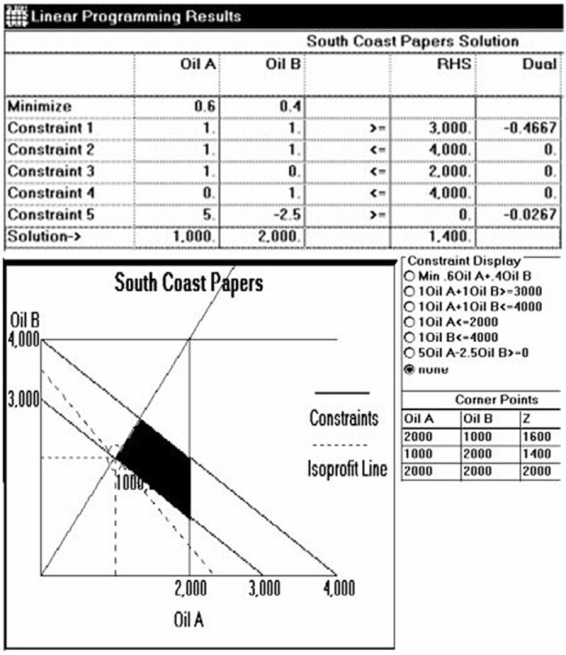Asked by Melisa Di?isa?lam on Jun 13, 2024

Verified
South Coast Papers wants to mix two lubricating oils (A and
B) for its machines in order to minimize cost. It needs no less than 3,000 gallons in order to run its machines during the next month. It has a maximum oil storage capacity of 4,000 gallons. There are 2,000 gallons of Oil A and 4,000 of Oil B available. The mixed fuel must have a viscosity rating of no less than 40.
When mixing fuels, the amount of oil obtained is exactly equal to the sum of the amounts put in. The viscosity rating is the weighted average of the individual viscosities, weighted in proportion to their volumes. The following is known: Oil A has a viscosity of 45 and costs 60 cents per gallon; Oil B has a viscosity of 37.5 and costs 40 cents per gallon.
State the objective and the constraints of this problem. Plot all constraints and highlight the feasible region. Use your (by now, well-developed) intuition to suggest a feasible (but not necessarily optimal) solution. Be certain to show that your solution meets all constraints.
Lubricating Oils
are substances applied to mechanical systems to reduce the friction between moving parts, aiding in smoother operation and longevity of machinery.
Viscosity Rating
A measure indicating the thickness or fluidity of a liquid under specific conditions.
Feasible Region
The set of all possible points that satisfy the constraints of an optimization problem, within which the optimal solution is found.
- Comprehend the fundamentals of linear programming, which encompasses decision variables, objective functions, and limitations.
- Ability to engineer linear programming models reflective of real-world predicaments.
- Employ graphic or corner-point approaches to address linear programming dilemmas.

Verified Answer


Learning Objectives
- Comprehend the fundamentals of linear programming, which encompasses decision variables, objective functions, and limitations.
- Ability to engineer linear programming models reflective of real-world predicaments.
- Employ graphic or corner-point approaches to address linear programming dilemmas.
Related questions
Rienzi Farms Grows Sugar Cane and Soybeans on Its 500 ...
The Graphical Method of Solving Linear Programming Can Handle Only ...
Constraints Are Needed to Solve Linear Programming Problems by Hand ...
The ________ Is the Set of All Feasible Combinations of ...
What Are the Requirements of All Linear Programming Problems